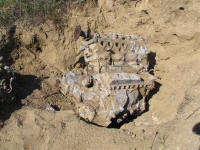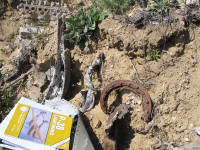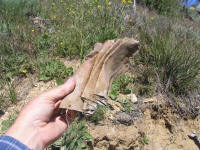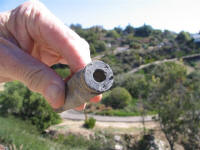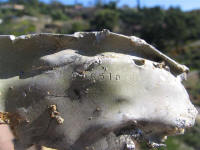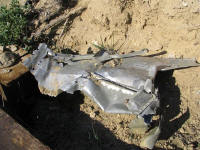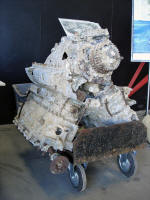|
Aircraft Wrecks in the Mountains and Deserts of the American West This Story Appeared on the Ventura
County Star Web Site Ventura County Star Unearthing the past Camarillo couple find parts from airplane that crashed in 1944 By
John Mitchell On May 4, 1944, an 8-year-old boy, standing with his firefighter father and a couple of volunteers in front of a Ventura County fire station, noticed something happening in the skies to the north, above Camarillo Heights. "We saw two planes just moments before they crashed," said Roger Putnam, now 69 and a board member of the Pleasant Valley Historical Society. "Later, I found out it was two fighter planes. We saw the pilots push back their canopies and parachute to the ground. I can picture it in my mind to this day; it really made an impression on a young kid." The next day, the weekly Camarillo News' front page said the pilots "miraculously escaped death" in the midair collision by parachuting to safety. One plane crashed and burned near the corner of Las Posas and Arneill roads on Thomas Ranch. The article said exploding ammunition kept sightseers away. The second plane fell in a canyon in the hills of Camarillo Heights. It exploded and set fire to the brush, burning several acres before the blaze was extinguished by the Camarillo Fire Department. The newspaper said the plane was destroyed. But not quite. For years, Dave and Paige Hibbits paid little attention to a chunk of metal that jutted about eight inches above the ground down a hill from their Camarillo Heights home in the 600 block of West Highland Drive. "My family bought the property in 1952," said Dave Hibbits, 59. "I had heard about the plane engine from the kid next door. The story had been handed down about planes colliding, the pilots bailing out." It wasn't until the Hibbits began putting in a walkway down the hill last year that the chunk of metal got close scrutiny. "We made a decision that we had to do something about it," said Paige Hibbits, 63, who is board president of the Pleasant Valley Historical Society. "So in December, after torrential rains, we went down there on a beautiful day with garden tools and started playing with it. The ground was soft and, over the weeks, we dug quite a bit. In early February, it was uncovered." What the digging revealed was a large, old airplane engine. Because Paige sensed historical significance, their find triggered a series of events. Paige Hibbits contacted Dave Flood with the Commemorative Air Force at Camarillo Airport. Vern Olson, a CAF mechanic, went to the site and identified the chunk of metal as an Allison V-1710 aircraft engine, probably from a Lockheed P-38 fighter plane. Flood contacted G. Pat Macha, 60, a Huntington Beach-based aviation archaeologist, who has investigated more than 1,000 crash sites in California. Macha and his sister, Cynthia Macha-Skjonsby, visited the site Feb. 16. They took photographs and found a number of pieces of debris from the crashed plane. One of the pieces had a Lockheed Aircraft identification number with the prefix "22," which identified the plane as a P-38 Lightning fighter. The P-38 was a twin-engine fighter. Macha said the engine that the Hibbits found was the plane's right engine. Paige Hibbits visited the vault in the historical society's museum and pored through the yellowing copies of the Camarillo News until she found the edition describing the crash. Four days after the 1944 accident, the Army had filed a formal report on its investigation. It included statements from the two pilots and another pilot in their four-plane formation. Macha got a copy of the accident report. On March 16, Macha, accompanied by Tom Maloney, an Orange County park ranger, returned to the Camarillo Heights crash area. Also on site was Walt Metcalf, 75, of the Commemorative Air Force. "While we were there, we found the left engine a short distance away from the first one," Metcalf said. If they can figure out how to haul the engines and parts to the airport, they hope to put the wreckage on permanent display in the CAF museum, he said. "This was just one crash of many, but it had a happy ending because both pilots survived," Putnam said. "My understanding right now is that the board of the historical society would be tickled to death to have the artifacts at the Commemorative Air Force museum. That would be the most logical place for them." Copyright 2006 Ventura County Star
Related articles the same day. For some in WWII, there were no happy landings Special thanks to Craig Fuller of AAIR for making the accidents reports available for the completion of this story. All photos by G.P.Macha |
|
|
